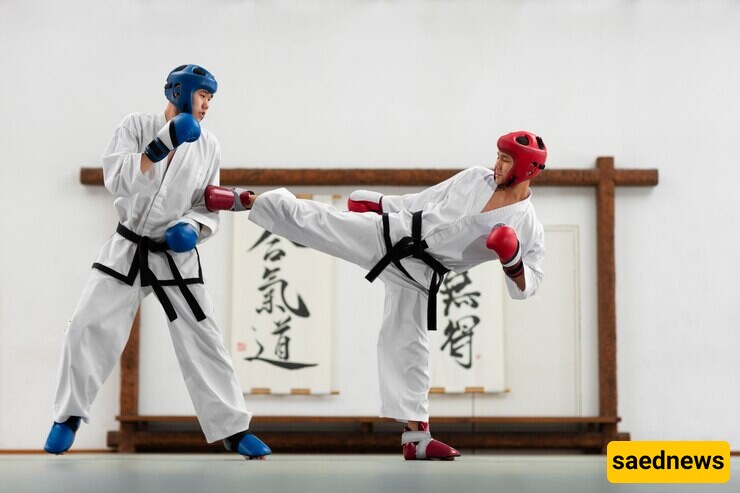SAEDNEWS: Both karate and taekwondo are highly popular sports with certain differences and similarities. In this article, we will highlight some of their differences. Stay with us for more.


Karate and taekwondo are martial arts that may appear similar at first glance but are distinct from one another. While they share many similarities, they cannot be considered the same. Beginners may find them confusing due to these similarities. Taekwondo is an ancient combat style, whereas karate has a more recent origin. These martial arts differ in their objectives, techniques, and associated risks.
Taekwondo is a Korean martial art emphasizing head strikes, jumping kicks, spinning kicks, and rapid techniques, with origins dating back over 2,000 years. Initially, it was a defense technique without a specific stance, called "Subak." Over time, "Taekkyon" emerged as a more refined form, and kingdoms mandated their soldiers to learn and practice it for combat readiness. In the early 20th century, during Korea's conflict with Japan, Japanese authorities banned Korean martial arts, but some groups continued practicing them in secret. Eventually, in 1955, a conference established a uniform for this sport, focusing on hand and foot techniques, which gave rise to the modern taekwondo style.
Karate originated hundreds of years ago in Japan's islands, now known as Okinawa, though its roots trace back to China. In the 16th century, unarmed locals in parts of China developed it as a means of self-defense. The term "karate" means "empty hand," highlighting its weaponless nature and self-defense focus.

In karate, 60% of techniques involve hand strikes, while 40% utilize kicks. This balance is evident in various katas (forms) and practices involving hypothetical opponents. In contrast, taekwondo emphasizes 60% leg techniques and 40% hand techniques. Taekwondo places more focus on high kicks and jumping techniques aimed at the opponent's head. Practitioners frequently perform jumping kicks, and its forms are slightly more limited yet more intricate compared to karate.
In North America and other parts of the world, official competitions are held separately for karate and taekwondo. In mixed martial arts tournaments, competitors from both disciplines may face each other, although separate categories often exist for Japanese karate and Korean taekwondo. Punching competitions are usually combined.
In karate, rank depends on skill level and commitment. There are two ranking groups: pre-black belt and black belt levels. Pre-black belt colors include white, orange, yellow, blue, green, purple, deep purple, and brown (with three subdivisions). To achieve higher ranks, karate practitioners must pass exams judged on their techniques, movements, and mindset. Earning a black belt is considered a new beginning, with grades ranging from 1st to 10th degree.
In taekwondo, rankings are divided into senior, junior, trainee, and instructor categories. Junior belts feature various colors, starting from the 10th grade and progressing to the 1st. Trainees must demonstrate their skills in areas such as board breaking, self-defense, and taekwondo techniques to advance. They also answer questions about taekwondo terminology and history to showcase their knowledge. At the senior level, taekwondo includes nine black belt grades, with the 9th degree reserved for true masters recognized by the International Taekwondo Federation.
Both sports use white uniforms, but their designs differ. Karate uniforms, called “gi,” have two-piece collars and are generally shorter and looser. Taekwondo uniforms, called “dobok,” have V-shaped collars and are longer and tighter. In taekwondo, full protective gear (helmet, mouthguard, chest protector, forearm guards, gloves, shin guards, groin guards, and foot guards) is used in matches. In karate, many styles use minimal protective gear, such as shin guards, foot guards, gloves, and mouthguards, with gloves being optional in some styles.
Both martial arts have specific rules and guidelines for competitions. In karate, strikes with hands and feet earn equal points. In taekwondo, kicks are awarded higher points, resulting in more kicks being used in competitions. Taekwondo injuries often involve lower limbs, such as sprains or strains, while karate injuries are more common in the head and face, with nosebleeds being the most frequent.
Both styles are beneficial for children's physical and mental development. The main difference lies in their focus: karate emphasizes self-defense maneuvers, while taekwondo focuses on competitive skills. For children who prefer smoother movements and full-body involvement, karate might be a better choice. However, for those interested in fast moves and precise kicks, taekwondo is preferable. Both martial arts promote coordination, patience, and endurance, with taekwondo being slightly easier due to its simpler techniques. Because girls tend to have greater flexibility than boys, taekwondo may be more suitable for them. Overall, the two sports are highly similar, with only minor differences.

